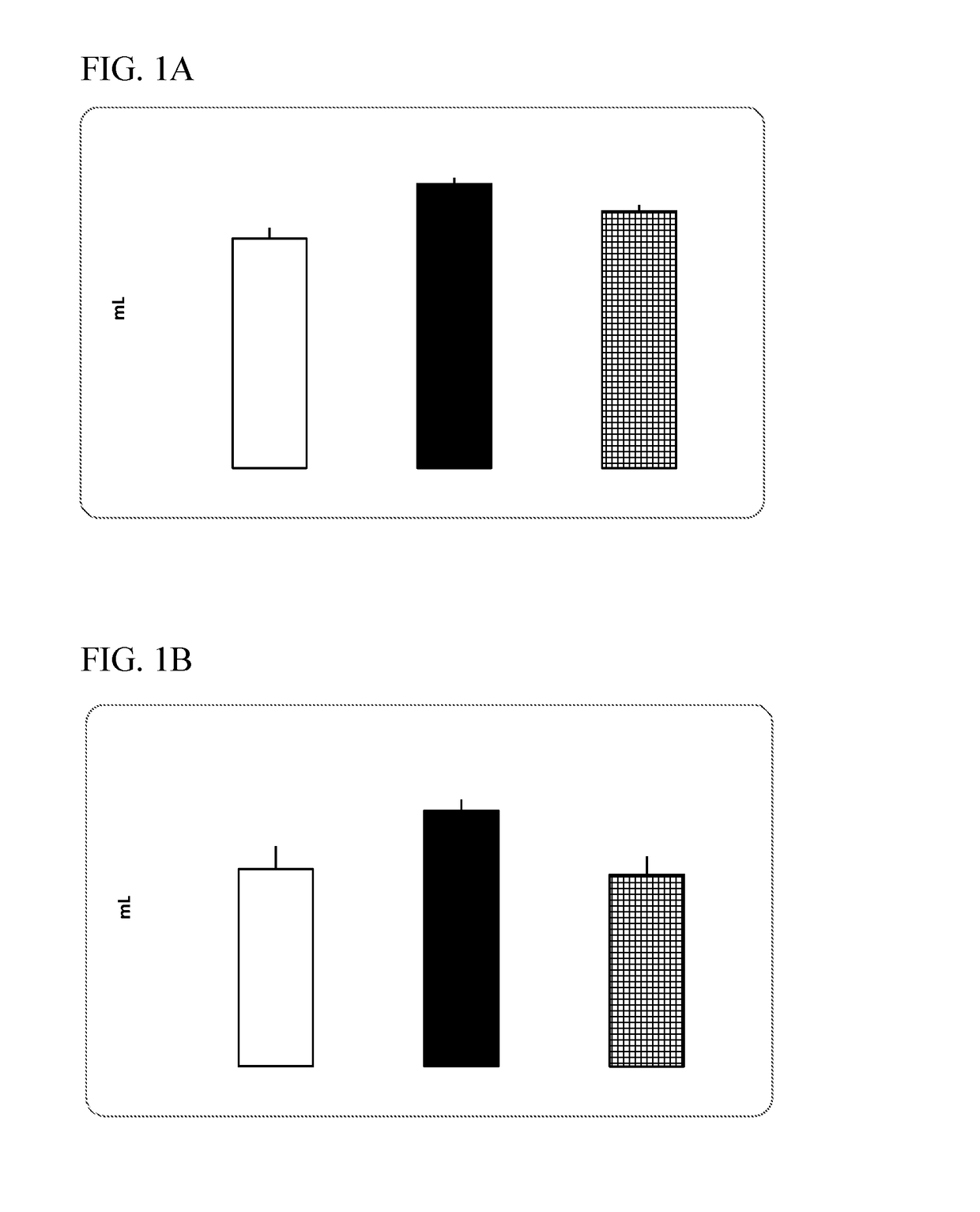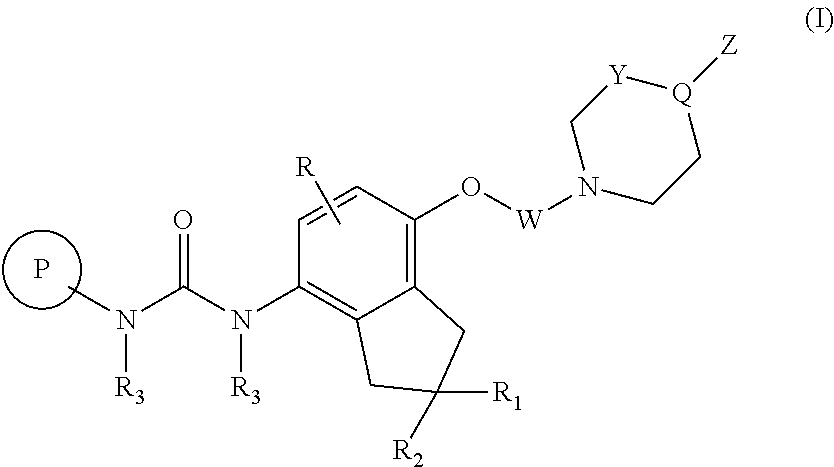P38 map kinase inhibiting indanyl urea compounds
a technology of indanyl urea and p38 map kinase, which is applied in the field of indanyl urea derivatives, can solve the problems of ineffective current treatment of failure to treat the underlying inflammatory disease in patients with chronic obstructive pulmonary disease, and ineffective copd treatmen
- Summary
- Abstract
- Description
- Claims
- Application Information
AI Technical Summary
Benefits of technology
Problems solved by technology
Method used
Image
Examples
example 1
Tert-butyl (7-hydroxy-2,3-dihydro-1H-inden-4-yl)carbamate (Intermediate 1)
[0075]
[0076]To a stirred solution of 7-amino-2,3-dihydro-1H-inden-4-ol (40 gm, 161 mmol) (prepared by the procedure as described in U.S. Pat. No. 6,203,580) and triethyl amine (26.71 ml, 192 mmol) in ethyl acetate (500 ml), di-tert-butylpyrocarbonate (37 ml, 161 mmol) was added over a period of 1 h at room temperature. The reaction mixture was further stirred at room temperature for 1 h. The reaction mixture was quenched by water, stirred and ethyl acetate layer was separated, dried over sodium sulfate and concentrated under vacuum to get residual solid. The residue was stirred in hexane (500 ml) for 1 h at room temperature. The solid appeared, was filtered and dried under vacuum to get 38.0 gm of title compound as solid.
[0077]1H-NMR (400 MHz, CDCl3): δ 7.19 (1H, d), 6.48 (1H, d), 6.11 (1H, s), 5.82 (1H, bs), 2.80 (4H, q), 2.03-2.10 (2H, m), 1.50 (9H, s).
[0078]ESMS: 250.08
example 2
2,2,2-trichloroethyl[3-tert-butyl-1-(4-methylphenyl)-1H-pyrazol-5-yl]carbamate (Intermediate 2)
[0079]
[0080]To a stirred solution of 3-tert-butyl-1-(4-methylphenyl)-1H-pyrazol-5-amine (80 gm, 349 mmol) (J. Med. Chem., 2002, 45, 2994-3008) and sodium bicarbonate (80 gm, 952.38 mmol) in tetrahydrofuran (500 ml), 2,2,2-trichloroethyl chloroformate (57 ml, 420 mmol) was added at 5-10° C. The reaction mixture was stirred at room temperature for 4 h. The reaction mixture was poured into water and extracted by ethyl acetate. Ethyl acetate layer was separated, dried over sodium sulfate and evaporated under vacuum to get crude compound. The crude compound was suspended in hexane (500 ml), stirred at 0-5° C. and separated solid was filtered and dried to get 102.0 gm of title compound as solid.
[0081]1H-NMR (400 MHz, DMSO-d6): δ 9.90 (1H, s), 7.35 (2H, d), 7.25 (2H, d), 6.26 (1H, s), 4.85 (2H, s), 2.33 (3H, s), 1.27 (9H, s).
[0082]ESMS: 403.90, 405.91
example 3
2,2,2-trichloroethyl{5-tert-butyl-3-[(ethylsulfonyl)amino]-2-methoxyphenyl}carbamate (Intermediate 3)
[0083]
[0084]Using the similar procedure as described for 2,2,2-trichloroethyl[3-tert-butyl-1-(4-methylphenyl)-1H-pyrazol-5-yl]carbamate (Intermediate 2) in Example 2, the title compound was synthesized from N-(3-amino-5-tert-butyl-2-methoxyphenyl)ethanesulfonamide (J. Med. Chem., 2007, 50, 4016-4026) and 2,2,2-trichloroethyl chloroformate.
[0085]1H-NMR (400 MHz, DMSO-d6): δ 9.44 (1H, s), 9.11 (1H, s), 7.34 (1H, s), 7.18 (1H, d), 4.93 (2H, s), 3.70 (3H, s), 3.09-3.20 (2H, m), 1.28 (12H, m)
[0086]ESMS: 460.95
[0087]Using the similar procedure as described for 2,2,2-trichloroethyl[3-tert-butyl-1-(4-methylphenyl)-1H-pyrazol-5-yl]carbamate (Intermediate 2), 2,2,2-trichloroethyl [3-tert-butyl-1-(3-chloro-4-hydroxyphenyl)-1H-pyrazol-5-yl]carbamate (Intermediate 4), 2,2,2-trichloroethyl[3-tert-butyl-1-(3-chloro-4-methoxyphenyl)-1H-pyrazol-5-yl]carbamate (Intermediate 5), 2,2,2-trichloroethyl [3...
PUM
| Property | Measurement | Unit |
|---|---|---|
| temperature | aaaaa | aaaaa |
| temperature | aaaaa | aaaaa |
| temperature | aaaaa | aaaaa |
Abstract
Description
Claims
Application Information
 Login to View More
Login to View More - R&D
- Intellectual Property
- Life Sciences
- Materials
- Tech Scout
- Unparalleled Data Quality
- Higher Quality Content
- 60% Fewer Hallucinations
Browse by: Latest US Patents, China's latest patents, Technical Efficacy Thesaurus, Application Domain, Technology Topic, Popular Technical Reports.
© 2025 PatSnap. All rights reserved.Legal|Privacy policy|Modern Slavery Act Transparency Statement|Sitemap|About US| Contact US: help@patsnap.com



